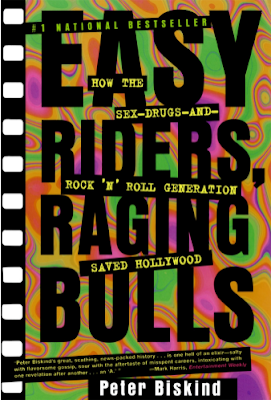"Easy Riders, Raging Bulls", Peter Biskind
New Hollywood (aka American New Wave) was a period in American film history that went from the mid-'60s to early '80s. Famous for a generation of filmmakers that had an unusual amount of creative liberty at the time (Francis Ford Coppola, Martin Scorsese, Brian De Palma, Paul Schrader...) its films, widely influenced by the European arthouse cinema, were audacious for their character-driven instead of plot-driven stories, technical and stylistic innovations, ambiguous endings and non-linear narratives. It is believed that this period began in 1967 with Bonnie and Clyde, whose violence and liberal portrayal of sex made it a commercial and critical success. It continued with the counterculture hit Easy Rider (1969) and through the '70s with the beautifully nostalgic The Last Picture Show (1971), the paranoid drama The Conversation (1974), the psychological disturbing neo-noir Taxi Driver (1976) among many other films that are still regarded as some of the finest of the American cinema. New Hollywood films reflected the political themes of that time (as in All the President's Men (1976)) and placed the spectator in a social and emotional level of uncertainty and doubt. However, the great successes of blockbusters (as Jaws (1975) or Star Wars (1977)) as well as the financial failures and critical misinterpretation of more artistic and serious films (as Sorcerer (1977) and Heaven's Gate (1980)) caused new changes in studios, that decided to invest more and more in escapism and merchandising products. Producers regained control, and the key authorial role of the director was lost in the mainstream, as New Hollywood's key figures were, little by little, stepped aside from the system and its economic resources. And where did it all end? Perhaps New Hollywood's swan song was Coppola's majestic and romantic vision of a Los Angeles inhabited by expressionist neons, melancholic melodies and a couple's regret, One From the Heart (1982).
Easy Riders, Raging Bulls: How the Sex-Drugs-and-Rock 'N Roll Generation Saved Hollywood is a book by film historian and journalist Peter Biskind (1940), published in 1998, that intends to describe the history of this filmic period, from a director and, simultaneously, studio perspective.
Excerpts:
"This was a time when film culture permeated American life in a way that it never had before and never has since. In the words of Susan Sontag, 'It was at this specific moment in the 100-year history of cinema that going to movies, thinking about movies, talking about movies became a passion among university students and other young people. You fell in love not just with actors but with cinema itself.' Film was no less than a secular religion."
"Lucas’s genius was to strip away the Marxist ideology of a master of editing like Eisenstein, or the critical irony of an avant-garde filmmaker like Bruce Conner, and wed their montage technique to American pulp. Star Wars pioneered the cinema of moments, of images, of sensory stimuli increasingly divorced from story, which is why it translates so well into video games. Indeed, the movie leapt ahead—through hyperspace, if you will—to the ’80s and ’90s, the era of non-narrative music videos, and VCRs, which allowed users to view film in a non-narrative way, surfing the action beats with fast-forward.
When all was said and done, Lucas and Spielberg returned the ’70s audience, grown sophisticated on a diet of European and New Hollywood films, to the simplicities of the pre-’60s Golden Age of movies, the era Lucas had memorialized so well in [American] Graffiti. They marched backward through the looking glass, producing pictures that were the mirror opposite of the New Hollywood films of their peers. They were, as Kael first pointed out, infantilizing the audience, reconstituting the spectator as child, then overwhelming him and her with sound and spectacle, obliterating irony, aesthetic self-consciousness, and critical reflection."
"Still, he [Coppola] was pleased. He had become the poet of the imperfect. 'Filmmaking is like winemaking,' he says. 'You got all these grapes, some of them are burnt, some of them are not quite ripe, some of them the sugar isn’t right, and with the winemaker’s sweat, you make great wine.'"
Link to the complete book in PDF:
https://drive.google.com/file/d/15rfxPsgZvZCLp6W2rIabeIerB4H2URu2/view?usp=sharing
 |
| From right to left: Steven Spielberg, Martin Scorsese, Brian De Palma, George Lucas, Francis Ford Coppola. |




Comments
Post a Comment